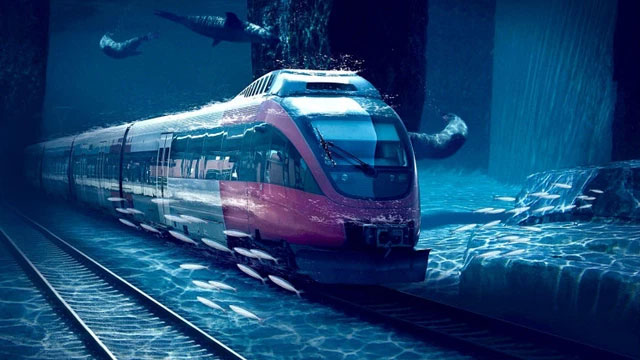China plans to spend 200 billion USD to build an underwater train line, reaching the United States in just 2 days
In order for the economy to maintain the country's internal resources, international trade efforts are always put on top. With big projects such as building a 13,000km train line connecting China and the US, humanity will witness a 'silk railway' bringing unimaginable benefits. But apparently, things are not that simple.
In 2014, a series of major newspapers reported on the railway being built by China. If successful, this will be a great achievement connecting the friendship between the two powers, while boosting trade and tourism activities and improving a variety of environmental factors. However, many years later, the future of the project remains a mystery.
From China to America in two days
The 13,000 km long track will go from China to Russia, to Canada and then to the US terminus. When passing through the Bering Strait, the narrow water connecting the Pacific and Arctic Oceans, the ship will have to use an underwater track to complete the journey.
When asked, Chinese officials confirmed the feasibility of the project. According to China Daily, China already possesses enough resources and high technology to carry out the utopian route.

We will be able to travel across continents in just 2 days with this train.
'Right now, we're talking. Russia has also considered this project for many years," Wang Mengshu, a railway expert at the Chinese Academy of Engineering, told The Guardian.
Take a shortcut across the Bering Strait to North America, we will be able to travel across the continent in just 2 days.
Is the train line connecting China with the US eco-friendly?
Normally, trains on rails are still considered the most environmentally friendly public transport. Trains can hold up to tens of thousands of passengers and have significantly lower emissions than cars. It is estimated that ships emit 14g of CO2 when carrying a passenger 1 kilometer, with aircraft this figure reaches 285g.
High-speed rail lines, used to carry both people and goods, are efficient. A train powered by renewable energy will deliver even more efficiency.

The data shows that the bullet train is environmentally friendly.
But how feasible?
According to The South China Morning Post, the estimated cost is up to 200 billion USD. The large amount of money is one of the many reasons the project has been delayed until now. But considering the already impressive Chinese rail system, with a total length of up to 37,000km, the ambitious project is still theoretically viable.
In addition, China has the fastest commercial maglev train system in the world. Connecting Shanghai Pudong Airport with the Shanghai metro system, the train line is powered by superconducting magnet technology to help Chinese people move quickly between the inner city and the suburbs.
From an environmental perspective, using trains as public transport will help reduce the amount of greenhouse gases that transport activities generate. A report published in 2019 found that high-speed rail helps "reduce environmental pollution in China by 7.3%".

German Chancellor Angela Merkel rides a Chinese maglev train in 2006.
Despite the benefits, the China-Russia-Canada-US rail link is still an expensive project. Many people think that railways are useless when air routes, sea routes serving the same purpose still exist, it is better to continue to use them than to spend $ 200 billion to build intercontinental railways.
Furthermore, the project will be a collaboration between countries with complicated political relationships. Another obstacle to making the dream train line come true.
At the present time, the intercontinental train line, with a section of track below sea level is still a dream.
- Coming soon there is faster train ... plane?
- America: snow prices cause at least 70 deaths, $ 1 billion in damage
- Russia will spend $ 50 billion on the aerospace industry
- What is special about the $ 27 billion metro project of New York City?
- Fighting meteors: Does the US or the planet spend the same money?
- Trails have to touch 60,000 ancient tombs
- Malaysian companies will spend heavily on information security
- NASA will spend $ 1.6 billion to develop a space taxi
- The FTC will prevent Google from acquiring DoubleClick
- The heat caused 13 deaths in the United States
- Japan runs the pilot train of the future
- FBI builds the world's largest bio-data bank
 America develops cruise missiles in formation
America develops cruise missiles in formation Develop smart contact lenses that the US military has been looking for for a long time
Develop smart contact lenses that the US military has been looking for for a long time Has found a solution to 'freeze' lithium ion batteries with liquid nitrogen, avoiding batteries to explode if there is a collision
Has found a solution to 'freeze' lithium ion batteries with liquid nitrogen, avoiding batteries to explode if there is a collision 6 best DNS changing software for Windows
6 best DNS changing software for Windows US experts warn about Covid-26 and Covid-32
US experts warn about Covid-26 and Covid-32  Good at 'copying technology', Vietnam's neighbor is accelerating: About to surpass the US?
Good at 'copying technology', Vietnam's neighbor is accelerating: About to surpass the US?  China releases first image taken by wide-field telescope
China releases first image taken by wide-field telescope  China launches unprecedented technological 'monster', solving mega-project that both the US and Japan are stumped by
China launches unprecedented technological 'monster', solving mega-project that both the US and Japan are stumped by  China successfully tests inflatable spacecraft capsule
China successfully tests inflatable spacecraft capsule  China produces the world's most powerful hydraulic cylinder
China produces the world's most powerful hydraulic cylinder 